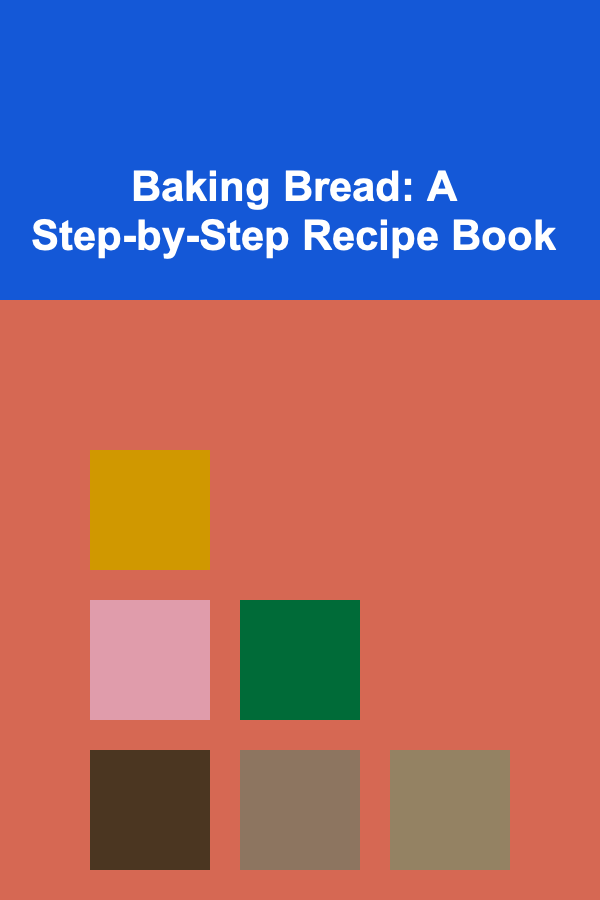
Baking Bread: A Step-by-Step Recipe Book
ebook include PDF & Audio bundle (Micro Guide)
$12.99$7.99
Limited Time Offer! Order within the next:

Baking bread is both an art and a science. The process brings together flour, water, yeast, and a touch of patience to create something both nourishing and delicious. The comforting aroma of fresh bread wafting from the oven is one of life's simple pleasures. But baking bread can be a daunting task for beginners, with countless techniques, varieties, and tools to consider.
This recipe book will guide you through the process of making various types of bread. From the basics of a classic loaf to more complex and creative options, you will learn everything you need to know to bake bread with confidence. Each recipe includes step-by-step instructions, tips for success, and ideas for variations that you can try. Whether you are a novice baker or an experienced home baker, this guide will help you unlock the secrets to delicious homemade bread.
The Essential Ingredients
Before we dive into the recipes, it's important to understand the basic ingredients that make up most bread recipes. These ingredients are simple but essential, and each plays a critical role in the bread-making process.
A. Flour
Flour is the foundation of bread. Most bread recipes call for all-purpose flour, which is versatile and easy to find. However, bread flour, which has a higher protein content, is often used in recipes that require a chewy, dense texture. There are also specialty flours such as whole wheat flour, rye flour, and spelt flour, each lending a unique flavor and texture to the bread.
B. Yeast
Yeast is a living organism that ferments the dough, causing it to rise. There are two main types of yeast used in baking: active dry yeast and instant yeast. Both types work in similar ways but differ in how they are added to the dough. Active dry yeast needs to be dissolved in warm water before use, while instant yeast can be added directly to the flour without activation.
C. Water
Water hydrates the flour, allowing the proteins to form gluten, which gives bread its structure and texture. The temperature of the water is important --- it should be warm, but not hot, to activate the yeast without killing it.
D. Salt
Salt not only enhances the flavor of bread, but it also helps to regulate the fermentation process, slowing it down to allow for better development of flavor. Salt strengthens the gluten network and contributes to the overall texture of the bread.
E. Optional Add-ins
Depending on the recipe, you may want to add ingredients like sugar (for sweetness and to help activate yeast), fats (such as butter or olive oil for richness), or eggs (for a soft, tender crumb). These ingredients can add depth and variation to your bread, but they aren't strictly necessary for basic recipes.
Basic Bread Recipe: The Classic White Loaf
Let's begin with the classic white loaf. This recipe is simple, straightforward, and perfect for beginners. It's the foundation for many other bread recipes, and mastering it will give you the confidence to experiment with more complex varieties.
Ingredients:
- 500g all-purpose flour (or bread flour)
- 300ml warm water (about 110°F/45°C)
- 10g salt
- 7g instant yeast (or 10g active dry yeast)
- 30ml olive oil (optional)
- 1 tablespoon sugar (optional)
Instructions:
-
Prepare the Yeast:
If using active dry yeast, dissolve it in warm water with the sugar. Let it sit for 5-10 minutes until the mixture becomes frothy. If you're using instant yeast, you can skip this step and add it directly to the flour.
-
Mix the Ingredients:
In a large bowl, combine the flour and salt. If you're using olive oil, add it to the flour mixture. Add the activated yeast mixture (or instant yeast and water if using instant yeast) to the bowl. Stir until a dough begins to form.
-
Knead the Dough:
Turn the dough out onto a floured surface and knead for about 8-10 minutes. The dough should be smooth, elastic, and slightly tacky to the touch. If it's too sticky, sprinkle a little more flour, but be careful not to add too much, as this can make the bread dense.
-
First Rise:
Place the dough in a greased bowl, cover it with a clean cloth, and let it rise in a warm place for about 1-2 hours, or until it has doubled in size.
-
Shape the Dough:
After the first rise, punch down the dough to release the air. Turn it out onto a floured surface and shape it into a loaf by folding the edges inwards and rolling it tightly.
-
Second Rise:
Place the shaped dough into a greased loaf pan. Cover it with a cloth and let it rise for another 30-60 minutes, or until it has risen above the edge of the pan.
-
Preheat the Oven:
While the dough is rising, preheat your oven to 375°F (190°C). Place a small pan of water at the bottom of the oven to create steam, which helps the bread develop a crisp crust.
-
Bake:
Once the dough has risen, place it in the oven and bake for 25-30 minutes, or until the bread sounds hollow when tapped on the bottom. The top should be golden brown.
-
Cool:
Remove the bread from the oven and let it cool on a wire rack. Allow it to cool completely before slicing to ensure the best texture.
Tips for Success:
- Be patient with the rising times. The longer the dough has to rise, the better the flavor will develop.
- Use a thermometer to check the temperature of the water before adding the yeast. It should be between 100°F-110°F (38°C-43°C).
- If you're not ready to bake the dough after the second rise, you can refrigerate it overnight and bake it the next day. Just bring it back to room temperature before baking.
Variations: Experimenting with Different Flours
While the basic white loaf is a great starting point, there are countless ways to change up your bread. Using different types of flour adds new flavors and textures to the final product.
A. Whole Wheat Bread
Whole wheat bread is made using whole wheat flour, which contains the entire grain, including the bran and germ. This gives the bread a denser, nuttier texture and higher fiber content.
- Substitute 100% of the white flour with whole wheat flour for a hearty whole wheat loaf. You may need to increase the water slightly, as whole wheat flour absorbs more liquid than white flour.
- Add 1-2 tablespoons of honey for sweetness, which pairs well with the earthiness of the whole wheat.
B. Rye Bread
Rye bread has a distinct flavor and is often denser than wheat bread. It's commonly used for making sandwiches, especially those with savory fillings like pastrami or corned beef.
- Substitute 50% of the flour with rye flour to create a light rye loaf. You can also use 100% rye flour for a denser, more flavorful bread.
- Add caraway seeds to enhance the flavor and give it a traditional taste.
C. Sourdough Bread
Sourdough bread is made using a naturally fermented starter, which contains wild yeast and bacteria. This fermentation process results in a tangy flavor and chewy texture.
- Create a sourdough starter by mixing equal parts flour and water and letting it ferment over several days. Once your starter is active, it can be used in place of commercial yeast in your bread recipes.
- Sourdough requires more time for fermentation, but the results are worth the wait.
Tips for Baking Success
As you get more comfortable with bread baking, you'll discover a few techniques that can make a huge difference in the final result. Here are some expert tips to help you bake perfect bread every time:
- Use a Digital Scale: Measuring flour by weight is more accurate than using cups, especially since the density of flour can vary.
- Don't Skip the Steam: Adding steam to the oven while baking helps create a crisp, golden crust. You can place a pan of water in the oven or spray the bread with water before baking.
- Check for Doneness: To check if the bread is done, tap the bottom of the loaf. If it sounds hollow, it's ready. You can also use a thermometer --- the internal temperature of the bread should reach 200°F (93°C) when fully baked.
- Let it Rest: Be patient and let your bread cool completely before slicing. This allows the interior to set properly and gives the flavor time to develop.
Conclusion
Baking bread is a rewarding process that combines science and art. With a little practice and the right techniques, you can bake a variety of breads that are perfect for any occasion. From the simplicity of a classic white loaf to the complexity of sourdough, the possibilities are endless. So gather your ingredients, roll up your sleeves, and start baking! With each loaf you make, you'll gain more experience and confidence, and before you know it, you'll be baking like a pro.

Becoming a Successful Customer Experience Manager: Tools and Techniques for Growth
Read More
How to Create a Cozy Reading Nook in Your Entryway
Read More
How to Plan a Cozy Winter Party at Home
Read More
How to Start Saving for a Down Payment on a Home
Read More
How to Utilize Rolling Carts for Mobile Essential Oil Storage
Read More
How To Identify and Combat Adware
Read MoreOther Products

Becoming a Successful Customer Experience Manager: Tools and Techniques for Growth
Read More
How to Create a Cozy Reading Nook in Your Entryway
Read More
How to Plan a Cozy Winter Party at Home
Read More
How to Start Saving for a Down Payment on a Home
Read More
How to Utilize Rolling Carts for Mobile Essential Oil Storage
Read More